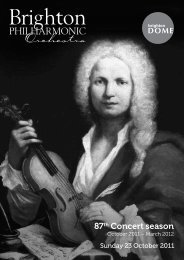Download Concert Programme - Brighton Philharmonic Orchestra
Download Concert Programme - Brighton Philharmonic Orchestra
Download Concert Programme - Brighton Philharmonic Orchestra
You also want an ePaper? Increase the reach of your titles
YUMPU automatically turns print PDFs into web optimized ePapers that Google loves.
Piano <strong>Concert</strong>o No.1in E flatFranz Liszt (1811-86)Allegro maestoso –Quasi adagio – Allegretto vivace –Allegro maestoso –Allegro marziale animatoLiszt’s career as atouring virtuoso lastedfrom his teenage yearsuntil 1848, when hedecided on a completechange of life. Hesettled in Weimar,where he had beenoffered the post ofCourt Music Director.Up to this point almostall of the music he hadwritten was for pianosolo, although ideas for the two concertosand Totentanz (his three most importantworks for piano and orchestra) had beensketched and drafted much earlier. Theearliest traces of the First Piano <strong>Concert</strong>odate back as far as 1830. It was the year Lisztmet Berlioz, and a year before his formativeencounters with Chopin and Paganini.Chopin’s poetic musical language had grownout of the idiom of the piano itself butPaganini’s influence extended even further.The famous violin virtuoso had exploded thenotions of what was considered possible onhis instrument – now Liszt was ready to dothe same with the piano. Liszt’s usualmethod was to compose at great speed andthen revise meticulously, often repeatedly.The First Piano <strong>Concert</strong>o was completed inWeimar in 1849 then thoroughly revised,first in 1853, and again in 1856 beforepublication. Liszt gave the first performanceof the <strong>Concert</strong>o on 17 February 1855, withBerlioz conducting.The First Piano <strong>Concert</strong>o reveals anexperimental approach to the matching ofsoloist and orchestra. Although Liszt divideshis score into three separate movements,the work is in fact played without a break.Furthermore, the second movement isactually a two-in-one structure containingboth a heart-felt slow movement and amore playful and mocking scherzo. Lisztsubjects his themes to a continuous processof variation and transformation, whichreplaces the formal developments of earlierconcertos. Themes reappear in differentmovements, settings and context – a radicalnew approach to form that would have farreaching effects. Eduard Hanslick, theconservative Viennese critic, was violentlyopposed to Liszt’s progressive ideas.Clutching at straws he took particularexception to the use of the triangle at thestart of the scherzo section of the secondmovement. Such was the critic’s influence,however, that the work was not played inVienna again for another twelve years.The <strong>Concert</strong>o opens in bravura style, withthe full orchestra and thundering piano setin opposition. As the movement progressesthe two work more in partnership togetheras they elaborate upon the opening theme.The slow movement gives prominence tothe piano, whose sustained melody owesnot a little to Chopin’s nocturne style.
















